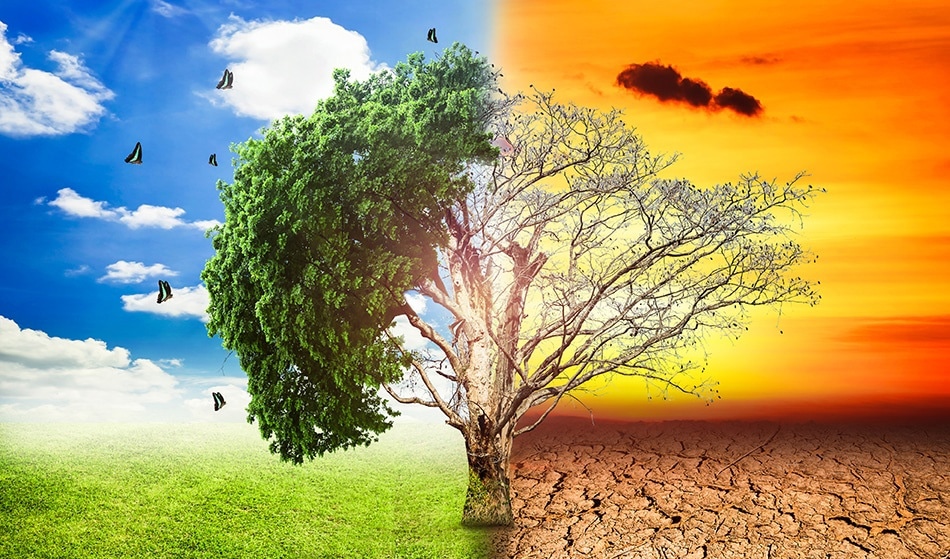
Image Credits: Zynatis/shutterstock.com
Climate change is an alteration in the climate system's statistical properties, including temperature, humidity, wind, and rainfall. It can be influenced by the oceans, land surfaces, atmosphere and ice sheets over geological time scales (usually at least 30 years). Climate changes occur as a result of both natural and human-induced causes.
Natural causes include “changes in the sun's intensity, volcanic eruptions, or slow changes in the Earth's orbit around the sun and other natural processes within the climate system such as changes in ocean current circulation.” These slow changes build up over decades or centuries and result in changes such as the recurring ice ages.
Man-made climate changes involve increasing atmospheric concentrations of CO2, methane, water vapor and nitrous oxide, and other chemically manufactured greenhouse gases. These include halocarbons, aerosols in the atmosphere which trap incident sunlight (the greenhouse effect), cutting down carbon-absorbing forests, causing ecological imbalances (e.g. pollution) leading to species or habitat loss, and energy-intensive activities that result in high carbon footprint.
In comparison, volcanoes only release around 2% of the CO2 produced by anthropogenic activities. Water vapor causes approximately half of the natural greenhouse effect. Increased water vapor concentrations are attributed to warming, and this “feedback doubles the sensitivity of climate to human activities.”
The temperature, atmospheric water vapor, the extent of polar ice sheets and the concentrations of long-lived greenhouse gases (especially CO2) in the atmosphere are all closely coupled to feedback systems that dictate climate change. The greenhouse gases emitted so far have already averted the next ice age. Without greenhouse gases, life on Earth would be impossible - the Earth would be frozen. Greenhouse gases trap the sunlight reflected from the Earth’s surface, retaining the heat energy and warming the Earth. We are now tipping towards one end of this balance where the greenhouse gases steadily increase in the atmosphere, primarily due to anthropogenic activities in the recent past. Scientists have now established that the concentration of these gases is directly linked to the average global temperature on Earth. 2014, 2015, 2016, and 2017 have been the four warmest years globally since 1880. What does this mean?
According to the fifth assessment report (AR5) of the Intergovernmental Panel on Climate Change (IPCC), the average global temperature has increased by 0.85°C from 1880 to 2012. This is known as global warming, one of the critical factors causing climate change.
Global warming is the long-term warming of the planet since the early 20th century and most notably since the late 1970s due to the Industrial Revolution and the increase in fossil fuel emissions. Worldwide since 1880, the average surface temperature has gone up by about 1°C (about 2°F) relative to the mid-20th-century baseline (of 1951-1980).
Climate change includes a broad range of global phenomena in addition to global warming, such as rising sea levels; accelerating ice melt in Greenland, Antarctica, the Arctic and mountain glaciers worldwide; shifts in flower/plant blooming; sweeping changes in food production conditions; and extreme weather events such as floods, storms, heat waves and droughts.
NASA's GRACE satellites, which have measured Earth’s gravitational field since 2002, have observed an acceleration of ice mass loss since 2009 in the land ice sheets of both Antarctica and Greenland. Increasing temperatures due to global warming and other human activities cause ice to melt.
The melting of polar ice means there is less ice to reflect the sunlight, causing more heat to be absorbed by the planet. As the ice melts, the thawing permafrost releases trapped methane. The forests and warming oceans emit stored CO2, further augmenting the greenhouse effect and contributing to climate change. The ramifications of climate change are numerous and include freshwater shortages; plant and animal extinctions; an increase in malaria, water-borne diseases and others; excess CO2 absorbed by oceans leading to acidification affecting marine life, particularly in coral reefs, leading to extinction.
The current levels of atmospheric concentrations of greenhouse gases are unprecedented in the last 800,000 years.
UN Report
The Arctic Sea is believed to be melting at a shocking rate of 9% per decade. Polar animals such as polar bears, ringed seals, sea turtles, and rainforest dwellers such as orangutans are all under threat. The sad truth of climate change is that most of the debilitating effects will persist for centuries even if the emissions are stopped now.
The good news is that we can still make a difference and avert a catastrophe for our planet, by human will and action starting now.
References and Further Reading
Disclaimer: The views expressed here are those of the author expressed in their private capacity and do not necessarily represent the views of AZoM.com Limited T/A AZoNetwork the owner and operator of this website. This disclaimer forms part of the Terms and conditions of use of this website.